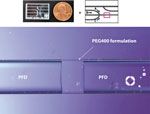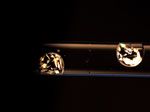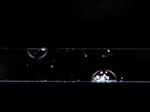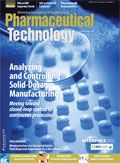Miniaturization of a Simulated Gastric Fluid Dispersion Experiment On a Microfluidics System
The miniaturization of preclinical safety assessment studies using a microfluidic chip system and optical microscopy can help reduce compound requirements, time, and costs in formulation development.
Formulations for preclinical safety assessment studies are often prescreened by formulation scientists in vitroprior to use in animal models. By simulating the precipitation characteristics of a formulation in biorelevant media, the performance of a formulation can be predicted. The predictability depends on the sensitivity of detection and simulation of the mixing of the vehicle and biorelevant media. The authors describe the miniaturization of these types of experiments using a microfluidic chip system, combined with detection by optical microscopy. The results show the potential of microfluidics as a tool to help reduce compound requirements, time, and costs in formulation development.
Dispersion experiments are heavily used in the pharmaceutical industry to screen potential oral formulations in vitro. The studies are run to rank how several formulations will perform prior to dosing new chemical entities in vivo. The experiment intends to mimic what occurs as the formulations are dosed orally and traverse through the gastrointestinal tract (1, 2). This experiment also is used to understand the mechanism of variability upon oral dosing. As a result, compound and animal resources can be spared when failed formulations are not pursued in actual animal studies. This experiment is particularly useful in drug discovery and development by saving time and resources while still advancing drug candidates.
Microfluidic systems
Microfluidic systems are evolving as useful tools for miniaturizing a variety of standard laboratory experiments (3). Many industries are using such systems, and more recently, the pharmaceutical industry is taking note (4). There are applications for microfluidics across the pharmaceutical industry ranging from scaling down the synthesis of challenging molecules to evaluating the effects of new chemical entities on biological systems (5).
Microfluidic systems are of particular interest to the pharmaceutical sciences as tools for formulation development. Emulsion-based formulations are highly prevalent in the industry. Okushima et al. demonstrated that monodispersed double emulsions could successfully be generated with tunable control over the size and number of internal droplets produced (6). In this example, a specialized chip with hydrophobic and hydrophillic junctions was used to generate the various double emulsions.
Liposomes also have been of interest to formulation scientists for several decades (7). Jahn et al. demonstrated the successful generation of liposomes on a microfluidics device (8). The liposomes generated were monodispersed, and the size of the particles was controlled by varying the flow rate. The mixing capabilities of the chip allowed liposomes to self-assemble in the channel, which would also allow for drug encapsulation and ultimately liposomal formulation preparation.
Both of these studies used droplet-based microfluidics. The liposome-generation example used the microfluidic technique of hydrodynamic focusing, and the double-emulsion example used T-junction droplet generation (9). With respect to droplet microfluidics, the methods are complementary. In general, droplet-based microfluidic systems have the advantage of creating separated droplets that distinguish small amounts of reagents (10). T-junction droplet-generation systems are particularly flexible as several T-junctions can be placed in tandem, thereby allowing sequential reactions or mixing opportunities to occur.
This article describes the use of a T-junction droplet microfluidics system to evaluate oral formulations of select model compounds by executing a simulated gastric fluid (SGF) redispersibility experiment directly on a microfluidics chip. This article describes preliminary proof-of-concept experiments. Morever, the results show the potential to save significant amounts of compound, animal resources, time, and cost in developing formulations for new chemical entities.
Experimental
The following materials were used in the study: naproxen (Chemical Abstracts Service [CAS] Number 22204-53-1, Sigma-Aldrich); naphthol (CAS Number 90-15-3, Sigma-Aldrich); perfluorodecalin (PFD) (CAS Number 306-94-5, Acros Organics), polyethylene glycol 400 (PEG 400, CAS Number 25322-68-3, Sigma Aldrich; Imwitor 742 (Sasol), and polysorbate 80 (CAS Number 9005-65-6, Tween 80, Fisher Scientific.
Formulations were prepared at 50 mg/g concentration representing a 100 mg/kg dose in vivo when PEG 400 is dosed at 2 mL/kg. Model compounds naproxen and naphthol were fully solubilized at this concentration. In addition, naphthol was prepared at 100 mg/g in 1:1 Imwitor 742:Tween 80. The compound also was fully solubilized. SGF was prepared by dissolving 2.0 g of sodium chloride (NaCl) in 1 L of deionized water and adjusting the pH to 1.2 with 1 N HCl (hydrochloride acid).
The microfluidics system was from Dolomite Microfluidics, and the experiments were run on a standard quartz T-junction chip with a channel size of 190 µm. The reagents were fed into the chip using three Dolomite Mitos Pressure Pumps (P-Pumps) with the pressure attenuated based on the viscosity of the liquids. The experiments were run at room temperature. After the experiments were completed, the chips were disassembled and transferred to either a Zeiss Axiovert 200M inverted microscope or a Nikon Eclipse E800 microscope, both equipped with a polarizing light filter to assess crystallinity.
Results and discussion

Figure 1: Quartz microfluidic channel chip used in experiments as compared to the size relative to a penny and the schematic representation of the chip (top) and the naproxen formulation in polyethylene glycol 400 (PEG 400) dispersed as a plug in the carrier fluid perfluorodecalin (PFD) (bottom). The plug is optically distinguishable from the carrier fluid and also traveled freely through the channel.The microfluidic system used for this study was the Dolomite pressure-based droplet microfluidics system. The experiment required three Mitos-P pumps with one equipped with a three-way outlet head. A standard quartz channel chip was used, which was optically transparent and stable to organic reagents. Figure 1 shows an image of the chip relative in size to a penny and also the schematic representation that is used throughout this article. In the T-junction schematic, the phase coming through Channel B would be considered the “dispersed” phase that would be dispersed within the “continuous” phase flowing though Channels A and C.
The lines are supplied by the Dolomite P pumps, with the pressures adapted to the individual viscosity of each liquid and until suitable droplet size is achieved (droplets of B within the carrier fluid channeled through Channels A and C).
The goal of these experiments was to see whether a typical redispersibility experiment could be performed on a droplet-generating microfluidics system. The redispersibility experiment involves preparing a formulation, either solution- or suspension-based, of a new chemical entity in a dosing vehicle and then dispersing the formulation into a biorelevant medium. Potential outcomes include the compound crashing out as either crystalline or amorphous physical phase or the compound remaining completely solubilized. If the starting formulation is a solution, when the compound of interest precipitates from the formulation vehicle, it is considered a less favorable formulation as this will render the active compound less absorbable in the intestinal barrier.
The initial experiment performed was to generate a plug of a solution formulation of naproxen dissolved in PEG 400 within the carrier fluid, PFD, to verify that the viscous PEG 400 would travel through the channel of the chip, which proved successful (see Figure ). PFD was chosen because as a fluorocarbon, it is immiscible with PEG 400 and the aqueous-based SGF. In this experiment, the carrier fluid was plumbed through Channels A and C as depicted in Figure 1, and the naproxen/PEG 400 formulation was brought in through Channel B. The naproxen/PEG 400 formulation was successfully “plugged” in the PFD carrier fluid and was visually distinct and traveled easily through the microfluidic channel.

Figure 2: Benchtop-dispersed droplets of a naproxen/ polyethylene glycol 400 (PEG 400) formulation in simulated gastric fluid within the microfluidics chip channel separated with the perfluorodecalin carrier fluid. The image was taken under polarized light.Next, the same naproxen in the PEG 400 formulation was dispersed into SGF on the benchtop, and the resulting suspension was plumbed through the chip. The experimental design was the same in that Channels A and C were the PFD carrier fluid and Channel B was the suspension of the naproxen formulation dispersed (on the benchtop) in SGF. This experiment verified that plugs of a formulation suspension could travel through the channel of the chip. For visualization, the chip was removed from the microfluidics chip-holder system and examined with polarized light microscopy. The characteristic birefringence was observed through the quartz chip, suggesting that the naproxen precipitates from the PEG 400 as crystalline material (see Figure 2).

Figure 3 (a): Schematic representation of the dispersion experiment plan. The yellow channel represents the simulated gastric fluid (SGF); the pink channel the naproxen dissolved in polyethylene glycol 400 (PEG 400); and the grey channel the perfluorodecalin (PFD) carrier fluid. Figure 3(b) is the schematic representation of the second dispersion experiment plan. The SGF droplets were created first and subsequently mixed with the formulation. The yellow channel represents the SGF; the pink channel the naproxen dissolved in PEG 400; and the grey channel the PFD carrier fluid.Dispersing the naproxen in PEG 400 formulation into SGF directly on the microfluidic chip was attempted next. The design of the experiment is outlined in Figure 3(a) . The naproxen in PEG 400 formulation (see pink channel, Figure 3 [a]), SGF (see yellow channel, Figure 3 [a]), and carrier fluid (PFD, see grey channel, Figure 3 [a] ) were plumbed into three separate lines with the intention of generating droplets of dispersed formulation in SGF separated by the carrier fluid at the junction of the chip. This experiment was somewhat unsuccessful as the high viscosity of the PEG 400 formulation line caused significant backflow issues. The formulation precipitated; however, there was no controlled droplet generation. Looking at the chip under polarized light indicates the naproxen/PEG 400 formulation crashed out of solution generating a crystalline precipitate, which was a promising result; however, more control was desired.

Figure 4. Droplets of the naproxen/polyethylene glycol 400 (PEG 400) formulation dispersed in simulated gastric fluid directly within the microfluidics chip channel, separated with the perfluorodecalin carrier fluid. The image was taken under polarized light.To achieve more control over the redispersibility experiment, the experimental design was changed. In the new experiment, SGF droplets (see yellow channel, Figure 3 [b]) were first generated in the carrier fluid [see grey channels Figure 3 [b]) and as they exited the chip, the exit line of tubing was replumbed into one of the bottom channels of the microfluidics chip. The second of the lower channels of the chip was plumbed with the naproxen in the PEG 400 formulation (see pink channel, Figure 3[b]). This experiment proved successful as once the formulation was dispersed into the SGF droplets, the new combined droplets continued to travel through the channel. In addition, the timescale was appropriate to observe the precipitation of the naproxen into crystalline material before the newly formed droplets exited the chip (see Figure 4).

Figure 5: Dispersion of the naphthol/Imwitor 742:Tween 80 formulation dispersed in simulated gastric fluid directly within the microfluidic chip channel. The image was taken under polarized light. Inset: nonpolarized light image.Having demonstrated that it is possible to perform a redispersibility experiment within a microfluidic chip, the final experiment aimed to differentiate between different formulations of a model compound. In this case, formulations of naphthol were prepared at 50 mg/g in PEG 400 and 100 mg/g in Imwitor 742:Tween 80. The difference in concentrations of these two formulations represents the difference in dosing volumes for the vehicles when administered at the same dose. The design of these experiments follows the schematic detailed in Figure 3(b). The naphthol formulation in PEG 400 was dispersed first. As the formulation mixed with the SGF droplets and traveled through the channel, there was no precipitation event (data not shown).
Imwitor 742:Tween 80 is a known self-emulsifying drug-delivery system (SEDDS) (11). SEDDS vehicles are typically comprised of oils and surfactants and solubilize highly lipophilic compounds. Upon reaching the aqueous environment of the stomach, the vehicle creates emulsions, which often boost in vivo exposure. When this formulation of naphthol was mixed with SGF droplets at the T-junction, the emulsifying nature of the vehicle was observed. This emulsion property is particularly evident when viewed under nonpolarized light (see Figure 5 inset). When viewed with the polarizing filter on the microscope, it is clear that the naphthol compound was precipitating out as evidenced by the birefringence observed at the interface of the two solutions. The precipitation, however, was somewhat impeded by the emulsification of the Imwitor 742:Tween 80 vehicle, and no distinct crystal habit was formed (see Figure 5).

Figure 6: Naphthol/polyethylene glycol 400 (PEG 400) formulation before and after dispersion into simulated gastric fluid (SGF) and naphthol/Imwitor 742:Tween 80 [1:1] formulation before and after dispersion into SGF.Having shown it was possible to disperse a formulation in SGF on a chip, a comparison experiment was conducted examining how the same formulations behave when dispersed in SGF on the benchtop. Standard SGF dispersion experiments were set up where the solution formulations of naphthol in PEG 400 and naphthol in Imwitor 742:Tween 80 [1:1] were dispersed into SGF at a ratio of 1:1. These experiments were run in small scintillation vials equipped with stirbars. Figure 6 shows the formulation vials prior to and after SGF dispersion. The results of the traditional benchtop SGF dispersion experiment parallel what was observed in the microfluidic dispersion experiments. Upon dispersion into SGF, the naphthol in PEG 400 formulation remained a solution, and the naphthol in Imwitor 742:Tween 80 [1:1] formulation became cloudy.
Conclusion
These experiments demonstrate the proof of concept that a dispersion experiment can be performed within a T-junction microfluidics chip system. When individual droplets of SGF were mixed with formulations at the T-junction, the model compounds either stayed in solution or precipitated out. When the compounds did precipitate out, information about the physical form of the precipitated chemical entity was obtained as the microfluidic chip is visualized under polarized light microscopy.
As there are significant benefits, scaling down redispersibility experiments also was explored by other groups. Dai and Mansky (12, 13) describe a method using a 96-well plate that uses a small amount of compound to screen the solubilizing effect of several excipients once dispersed into simulated intestinal fluid [SIF]. The method is further validated by comparing the results of the miniaturized experiments to traditional formulation dissolution testing and actual in vivo studies (14). In addition, Gopinathan et al. (15) developed a 96-well plate based high-throughput formulation screening strategy. The company TransForm (16, 17) has developed similar high-throughput formulations screens, even extending to a 384-well plate. For these examples, the reagents are mixed by vortexing or sonicating the plate, or in some cases, heating to solubilize the initial compound. These examples illustrate the direction the pharmaceutical industry is headed with respect to formulation screening in the discovery space: using small amounts of compound to evaluate many different formulations. The experiments detailed in this article are complementary as they use microfluidic technology, specifically T-junction droplet generation. Although not as developed as the aforementioned examples, this method offers the potential benefit of in situ mixing that droplet microfluidics offers (18, 19). This feature would be beneficial when highly viscous formulations are evaluated and may be a better representation of how formulations are dynamically mixed in the gastrointestinal tract. Further, microfluidic technology has the potential to consume even less compound than what would be used in a 384-well plate experiment.
Future experiments under consideration by the authors include a two-step SGF and fasted state SIF redispersibility study that would more closely mimic the transport of a compound from the acidic environment of the stomach to the more neutral pH (i.e., pH 6.5) of the small intestine. In addition, the system can be temperature-controlled, and the effect of temperature on these types of experiments may be explored.
In summary, scaling down redispersibility experiments to the microfluidic scale has the potential to have significant impact on how formulations are screened in the pharmacuetical industry. Performing redispersibility experiments on a much smaller scale allows more formulations to be screened in vitro using less material. When combined with more powerful detection techniques, the experiment also can provide more understanding of the behavior of the physical phase in the gastrointestinal environment. This information can help formulation development scientists identify and understand the most effective formulations for future in vivo experiments more efficiently.
Acknowledgement
The authors gratefully acknowledge the New Technology Research License Committee of Merck & Co. for funding these experiments as well as Richard Gray, head of sales at Dolomite for helpful discussions.
References
1. P. Li and L. Zhoa, Int. J. Pharmaceutics 341 (1-2), 1-19 (2007).
2. J.B. Dressman and C. Reppas, Eur. J. of Pharm Sci. 11 (S2), S73-S80 (2000).
3. X. Casadevall i Solvas and A. deMello, Chem. Commun. 47 (7), 1936-1942 (2011).
4. Y. Wen and S.T. Yang, Expert Opin. Drug Discov. 3 (10), 1237-1253 (2008).
5. L. Kang et al., Drug Discovery Today 13 (1/2), 1-13 (2008).
6. S. Okushima et al., Langmuir 20 (23), 9905-9908 (2004).
7. V. Ravichandiran, K. Masilamani, and B. Senthilnathan, Der Pharmacia Sinica 2 (1), 19-30 (2011).
8. A. Jahn et al., Langmuir 23 (11), 6289-6293 (2007).
9. S.Y. Teh et al., Lab Chip. 8 (2), 198-220 (2008).
10. P.A. Tabeling, Lab Chip. 9 (17), 2428-2436 (2009).
11. A. Pathak et al., Drug Invention Today 2 (2), 123-129 (2010).
12. W-G. Dai et al., Int. J. Pharmaceutics 336 (1), 1-11 (2007).
13. P. Mansky et al., J. Pharm. Sciv. 96 (6), 1548-1563 (2007).
14. W-G. Dai et al., J. Pharm. Sci. 96 (11), 2957-2969 (2007).
15. S. Gopinathan, A. Nouraldeen, and A.G.E. Wilson, Future Med. Chem. 2 (9), 1391-1398 (2010).
16. C.R. Gardner, C.T. Walsh, and O. Almarsson, Nature Rev. Drug Disc. 3 (11), 926-934 (2004).
17. C.R. Gardner et al., Comp. Chem. Eng. 28 (6-7), 943-953 (2004).
18. H. Gu, M.H.G. Duits, and F. Mugele, Int. J. Mol. Sci. 12 (4), 2572-2597 (2001).
19 X. Casadevall i Solvas et al., Anal. Chem. 82 (9), 3950-3956 (2010).
Nicole L. Hill*, PhD, is a principal scientist in the Basic Pharmaceutical Sciences Group at Merck & Co., 2015 Galloping Hill Road, Kenilworth, NJ 07033, tel: 732.594.2009, nicole_hill@merck.com. Todd Nelson, PhD, is an executive director in the Process Chemistry Group, Tim Rhodes, PhD, is a senior principal scientist in the Analytical Sciences Group, and Allen Templeton, PhD, is an executive director in the Basic Pharmaceutical Science Group, all at Merck & Co. Elizabeth Kwong, PhD, is a consultant with Kwong Eureka Solutions, and formerly a senior scientific director with the Basic Pharmaceutical Sciences Group at Merck & Co. Brian Farrer, PhD, is a principal scientist at Liquidia Technologies, and formerly a principal scientist with the Basic Pharmaceutical Sciences Group at Merck & Co.
*To whom correspondence should be addressed.
Submitted: Oct. 2, 2012; Accepted Nov. 12, 2012.
All figures are courtesy of the authors

Full Tolerance Coverage Method for Assessing Uniformity of Dosage Units with Large Sample Sizes
March 10th 2025The ‘full tolerance coverage method’ is introduced as a coverage estimation approach for assessing the uniformity of dosage units from large sample sizes, ensuring that no dosage unit exceeds the specification range.
Legal and Regulatory Perspectives on 3D Printing: Drug Compounding Applications
December 10th 2024This paper explores the legal and regulatory framework around 3D drug printing, particularly for personalized medicine, considering regulatory compliance, business concerns, and intellectual property rights.
Determining Low PPB Levels of Nitrite in Polymeric Excipients
September 9th 2024In this paper, the authors introduce a method that combines ion exchange chromatography with an easier-to-perform, simpler one-step post-column derivatization that is selective to nitrite and visible spectrophotometric detection to allow high sample loading volumes without affecting resolution.
The Role of Dry (Water-free) Process Equipment Cleaning in Continuous Pharmaceutical Manufacturing
August 11th 2024The growing use of continuous manufacturing in the pharmaceutical industry merits a review of the application of dry cleaning and sanitization methods, especially for non-sterile oral solid drug product manufacturing of dry powders.